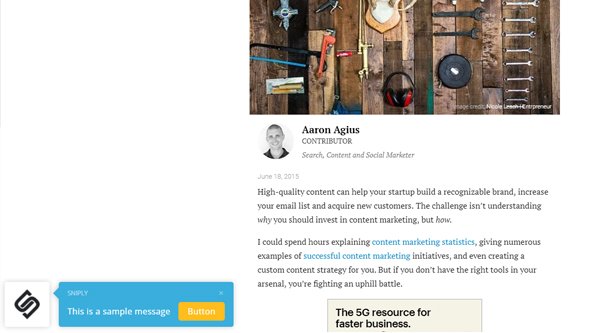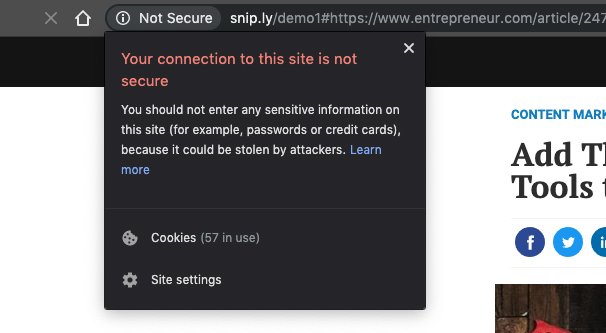How to Use Sniply to Get More Social Media Conversions

Guest blogging is a technique where you spend time creating powerful content for websites other than your own, with the intention of building up brand awareness and positioning a link on the blog you’re writing for. This link leads back to your site, and can bring in traffic as well as brand awareness.
The thing is, it’s tricky and time consuming to perform all of the outreach, all of the content creation, and all of the engagement necessary for a successful guest link. Even then, the link is as likely as not to be buried in an out of the way corner of the text, or even relegated to your author bio, where few people see and fewer click.
So, what if I told you that you could get a link on any site at all, and you didn’t have to work for it? Does that sound like a dream come true? You can do it, and I’ll tell you how.
Enter Sniply
Sniply, found on snip.ly, is a very interesting modern web tool. Some of the internet marketing veterans may find it eerily familiar, however. So what is it, and what does it do?
Sniply is a call to action tool and a URL shortening tool rolled into one. If that doesn’t seem like much, click this link and tell me if anything stands out.
When you click that link you’ll be taken to Entrepreneur, but there’s something more, something that isn’t normally there. Down there at the bottom, you see a Sniply box with “This is a sample message” and a button labeled Button. That button, if you click it, takes you to Sniply itself, with UTM parameters tracking what you did.
So what just happened here? It’s actually pretty simple and surprisingly elegant. Someone – the Sniply crew specifically – fed a full size link into the Sniply URL shortener. That full size link was the link to Entrepreneur. This generated a shortlink, specifically the snip.ly/demo link I gave you above.
When you clicked this link, you were taken to the destination of the link, which was the Entrepreneur post. At least, that’s what it looks like. However, if you look at the top URL bar of the Entrepreneur post, you see something a little different. You see, specifically, http://snip.ly/demo1#https://www.entrepreneur.com/article/247234.
What’s actually happening is that you’re being brought to Sniply itself, which is loading the full content of the page at the other end, but on their own domain. This allows them to, well, basically do anything they like. Since they’re providing a very narrow tool with a very narrow purpose, that’s all the do. They provide that small pop-over call to action button in the lower left corner.
That button, by the way, is the meat of what Sniply really does. When you have a Sniply account, you can create these shortlinks and customize the button that shows up on the page. If the user clicks the button, they are taken to the link you customize. In the case of the demo, that full size link was the link to Sniply complete with UTM tracking parameters. In your case, it will likely be a link to your landing page or your blog posts, with a relevant call to action in its place.
Now, you may notice a few differences between the Sniply version of Entrepreneur and Entrepreneur itself. The Sniply version doesn’t do any ad blocking, but it does eliminate some scripts that run on Entrepreneur if you don’t have your own blocking. When I load that Entrepreneur post on its own, I get a drop-down ad on the top of the screen, an ad between the content and the navigation, and a bar with more related content across the bottom. See this image for example:
By contrast, when I load it with Sniply, I don’t get any of the navigation, the dynamic ads, or even the broad-screen version of the page. Instead, I get a narrower version that is simpler and more pared down. See this image:
This is actually Entrepreneur’s adjustments, as far as I can tell. Sniply is loading the content in a narrow viewport, which is more suitable to mobile devices, and that scrunches down the window and collapses the broader dynamic content.
If you’re a veteran marketer, remember how I said this would feel familiar? Remember back when it seemed like every website was using iFrames to load other websites in windows within themselves, where they could still showcase their own navigation and/or advertising? Some companies made that their entire business model, while some used it for aesthetic or navigational purposes. Google put the kibosh on that because it wasn’t search friendly and because it was being abused for advertising. Since Sniply isn’t loading ads in their windows, or really loading anything improper at all, Google is unlikely to care.
Sniply’s Features and Pricing
Sniply has more than just the one call to action button I’ve shown above, that’s just their demo. They have that button, but they also have a form for users to opt-in to your mailing list without ever visiting your site. They can include a text hyperlink or an image banner link, or they can hide their content entirely and solely act as a link shortener and tracking app.
There’s plenty of customization as well. You can theme your snips, you can choose your custom colors, and choose the specific position where it will appear on the page. You can customize your shortlink – the snip.ly/thispart – or you can choose the domain, if you have one to connect. You can also remove the Sniply branding, with paid accounts.
Sniply wouldn’t be complete without data harvesting. They have analytics for your clicks and conversions, the tracking pixel necessary to track individual site actions, and split testing options.
They can also integrate with third party apps. It has browser extensions for Firefox, Safari, Chrome, and Explorer/Edge to make your links on the fly. It has integrations with popular platforms like Buffer, Hootsuite, and Zapier. And they have an API for you to build your own app if you so desire.
Pricing is limited by the number of clicks they forward per month. The free plan is only 1,000. Basic is 5,000, Pro is 20,000, Business is 50,000, and Agency is a quarter million. Other aspects of plans scale up as well; the number of team members and brands you can attach changes. The free plan only has button and text snips as well as the hidden snip; you need paid plans for Forms and Images. Many of the customizations and testing options are paid-only features as well. You can see the full comparison chart here.
As far as pricing is concerned, the free plan is, of course, free. Basic is $30 per month, Pro is $80 per month, Business is $150 per month, and Agency is $300 per month. You can try out any plan for two weeks before paying, to make sure it has features you want.
The Ramifications of Sniply URLs
Now, you may have noticed a few other quirks with this, and you may have thought of some consequences of using it. I know have. So let’s talk about it. Sniply is not a perfect system.
The first and the biggest issue that I see with Sniply is simply that it’s loading third party content on their domain. This, by necessity, means the content is not SSL certified. You’ll notice the big “not secure” icon at the top of the Sniply demo; Entrepreneur uses SSL, but Sniply’s version does not.
This isn’t an immediate issue. Certificate issues aren’t going to pop up and make the URLs not work. My concern is more of a long-term “if this becomes prevalent” concern. If tools like Sniply become mainstream, it means people will be less able to trust a URL. Or, rather, they will become too trusting of filtered and layered URLs like Sniply’s format, which means man-in-the-middle attacks, phishing sites, and other scams have an easier time of things.
Sniply, of course, is not a scam in any way. They’re a perfectly legitimate site and a legitimate business. The problem comes if some other person takes their idea and uses it to scam people.
The second ramification is that this is only for the page linked with the Sniply shortlink. If you click any of the links in the Entrepreneur article above, it will take you to exactly the page they should take you. Unlike iFrames, Sniply does not follow from page to page, loading its own CTA on top of everything. This is good, because this is part of how it maintains search value rather than becoming an indexing black hole like iFrame sites do.
A third ramification is only theoretical as far as I know. A site could decide that they don’t like Sniply adding CTAs over their content and could block the domain. Depending on how each side does it, there could be domains that block Sniply from loading their content, which would mean they wouldn’t work when Sniply tries to load them. You’d essentially get an error page or a blank page with the Sniply CTA on it. I don’t know that any domain has attempted to do this, or if Sniply has a contingency in place if it happens, though.
How to Use Sniply Properly
Initially I compared Sniply to getting a link from a domain through a guest post, but that’s not really how it works. For one thing, Sniply’s links aren’t indexed in any way, and they’re not officially endorsed by the site they’re on. Entrepreneur doesn’t sanction Sniply’s link up there. Sniply links don’t provide SEO value; they’re solely about traffic through a customized call to action button, or opt-ins through their forms.
One thing you don’t want to do is try to include a Sniply link that leads to your own site. If you’re linking to your own site, you should have plenty of other forms of call to action already, and you can control it yourself. There’s no need to use or pay for a third party service for those little jQuery boxes or overlays, you know.
Instead, the proper use is to use Sniply shortlinks when you’re linking to content on third party sites. You can do this on your website, but since the point of Sniply is to get people to go to your website, you don’t really need to get people who are already on your site to come back. They’re already there!
No, what you should do is use it on your social media profiles. On your Facebook posts, on your Twitter posts, in your Pinterest pins, and anywhere else you post online. When you link to a third party site, like Entrepreneur, use a Sniply shortlink. When people who only see your Tweets because they were retweeted, or who only see your Facebook posts because of a share, click your links, they will be taken to the Sniply version of the Entrepreneur post – or whatever post you’re curating – with your CTA on it. Ideally, they will view this as a bit of native advertising, will ignore the URL in their top bar, and will click the link leading to your page.
How well does Sniply work? You tell me! I’m sure some of you have experience with it, or are willing to give it a try. Let me know in the comments how well it has worked for you as part of your content curation strategy.










You mention using it on your Pinterest pins – the last I checked Pinterest had banned Snip.ly and bit.ly links. Has that changed?